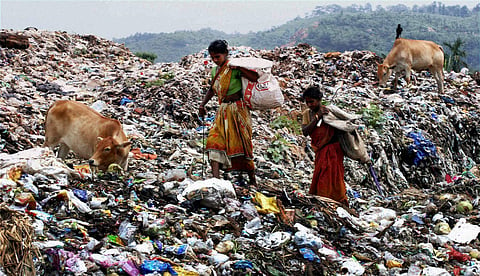

BENGALURU: Bengaluru Solid Waste Management Limited (BSWML), in collaboration with Bruhat Bengaluru Mahanagara Palike (BBMP), is set to optimize the process of waste collection and elimination with three more 150 tonne per day (TPD) waste transfer stations. Recent reports also revealed that after six years, BSWML is planning to conduct a fresh survey to re-estimate the waste generated by households and commercial establishments, and bulk waste generators. A tender for conducting a ‘Survey of Waste Generators (block mapping) and digital mapping’ has been set at Rs 4.50 crore.
While the government continues to fund initiatives to tackle waste issues in the city, which is estimated to produce about 6,000 TPD, a report by Hasiru Dala, an organisation that works for the betterment of the waste pickers’ community, revealed there could be a better option and also a boon for the environment.
Tonnes of carbon dioxide (CO2) can be mitigated by adopting decentralised methods of segregation and disposal of waste. The study was conducted between January and December 2022 and the report was released recently. Around 90 waste pickers from seven dry waste collection centres (DWCC) in Jayanagar block in the city were successful in reducing 1,743 tonnes of carbon emissions per year, and aiding in mitigating greenhouse gas emissions.
The ‘Decentralised Waste Management: A mitigation strategy for climate change’ report also revealed that 17.11 tonnes of CO2 equivalent per year is mitigated by the textile project in which cloth waste is collected separately and audited in the DWCC of Ward 177. The organisation used the Greenhouse Gas Equivalency Calculator to estimate greenhouse gas emissions and said the “1,763 tonnage is the equivalent of removing 392 passenger cars from the road per year”, read the report.
While conducting the study, researchers identified the landfill type and then looked at wet, dry and mixed as different categories, and how much emissions can be mitigated. Transportation of waste to landfill or other units was also calculated and emissions due to less energy-intensive sorting or preprocessing were also considered.
“Today, plastic has reached our oceans and is a huge problem. This is evidence that waste pickers and centres play a huge role in mitigating emissions and the difference they make. We need to understand that segregation at source is crucial,” said Roy Anto, Lead Author of the report.
He added that we need to push for more advocacy measures to introduce decentralised systems.
The study highlights that zero waste implementation has a huge potential to divert waste from landfills and prevent greenhouse gas emissions. Roughly 2.5 tonnes per day of dry waste is collected at DWCCs, which is diverted from reaching the landfill.